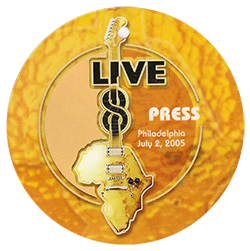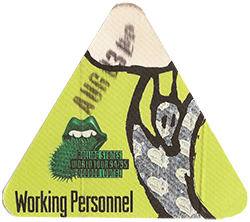So, You Want to Shoot Concerts? - Primer
 I recieved my September issue of Professional Photographer magazine this weekend that contained an article by David Bailey titled "Get Ready to Rock". Fine piece, except David glossed over an important point. He writes:
I recieved my September issue of Professional Photographer magazine this weekend that contained an article by David Bailey titled "Get Ready to Rock". Fine piece, except David glossed over an important point. He writes:
When you arrive at the concert venue, you're sometimes required to sign a contract stating the planned usage of the photographs and agreeing to certain restrictions.There are a few problems with that statement.
1) The publication you're shooting for will not agree to restrictions to, say, just the newspaper, as it precludes online use. You're signing away restrictions you are not allowed to, since you're not authorized to engage in contracts on behalf of the publication.
2) If you sign it, and it's just for the newspaper, your own use on your website will be precluded.
(Continued after the Jump)
Concert photography has been made difficult over the years. the space between Row 01 and the stage is called "the buffer", or "the pit", depending upon who you ask. Typically, there's heavy metal security fencing there, with about 4 feet between the fence and the physical stage's edge. That's the workspace we have. When the pit fills with people with point-and-shoot cameras, you typically know that they are fans with credentials (FWC, for short). They're there because they just want to photograph the band, and someone gave them a credential. You'll likely never see their work in print, unless you're looking at their desk in their cubicle. These are the same people who, during a post-show press conference, feel it necessary, before asking their inane question like "did you have fun out there tonight", to tell the artist something like "I just love your music, I have all the albums/CD's back until when you started...". Begin eye-roll....now.
 When you're in the pit, unless you have a pass like the one to the left or right, you'll get the boot after a very short period of time. For a Neil Diamond concert some years ago, it was 90 seconds, for recent Beyonce concerts, it can be as short as 50 seconds. Many times, it's first song, or first three songs. The truth is - if you are a professional, and you know what you are doing, you can accomplish your assignment needs within that period of time.
When you're in the pit, unless you have a pass like the one to the left or right, you'll get the boot after a very short period of time. For a Neil Diamond concert some years ago, it was 90 seconds, for recent Beyonce concerts, it can be as short as 50 seconds. Many times, it's first song, or first three songs. The truth is - if you are a professional, and you know what you are doing, you can accomplish your assignment needs within that period of time.  Further, the artist will look their best at the beginning of the show, when they've not perspired through their wardrobe. And two last points worth making - 1) the artist knows the press will be there, and is usually performing to appeal to their visual needs, and 2) the lighting is often brighter at that time because they know the press needs decent lighting to capture the artist at their best.
Further, the artist will look their best at the beginning of the show, when they've not perspired through their wardrobe. And two last points worth making - 1) the artist knows the press will be there, and is usually performing to appeal to their visual needs, and 2) the lighting is often brighter at that time because they know the press needs decent lighting to capture the artist at their best. None of this though, gets to the point about concert releases, but, is rather just a primer. To the left is one from a concert I did several years ago, but the language hasn't changed much on the photo release, as seen below.
None of this though, gets to the point about concert releases, but, is rather just a primer. To the left is one from a concert I did several years ago, but the language hasn't changed much on the photo release, as seen below.
Sometimes, the release grants the artist all rights to the photos, sometimes it requires you to get permission before any photo is sent out, sometimes, it's any one of a number of egregious demands by the artist. One venue local to me has a strange contract - since the union is the one who lit the stage, they argue that they are entitled to 50% of your income from any image licenses, and they exclude only "local papers" from this requirement. That's some union contract.
So, what kind of a predicament are you in? Well, let's examine your situation. You are given the green light to photograph the artist at the venue. If the publicist has sent over to you or your editor, a release like the one above, take the time to review it, and then object.
Many photographers use as a (poor) excuse for accepting low low assignment fees, is the value of the resale of images following the assignment and it's associated embargo period. Signing off on these terms means you'll earn zero, and, more than likely, not be allowed to have the images on your site in the first place. This should also be explained to your assigning editor, and they should go to bat for you, telling the artist's publicist that those terms are not workable, and that, without changes, the publication won't be covering the show. This does work, more often than you think. If you think it's ok to take the low low assignment fee, and sign the deal, then you're really just accepting the assignment to be closer to the band then you'd ever otherwise be allowed to be, so you're not really there to photograph them in the first place - thus, you're in the way of real working photojournalists, so get back to your nosebleed freebie tickets you got.
When this release is presented to you right before you're about to go out to make pictures, it's quite easy to make the legal assertion that this non-negotiable contract is, in fact, a contract made under duress, or is a contract of adhesion, since it is so one-sided in favor of the party presenting it to you. So, in both circumstances, the contract can be nullified.
There are, however, two other problems when you're asked to sign something. The first is that there is no place for the artist/label to counter-sign, which is a requirement for a legally binding contract. Both parties must be signatories to the agreement. The second is, you are never provided a counter-signed copy for your files (nor is there a witness either). These two issues also can cause the contract to be nullified.
Pearl Jam is fairly well known for their contract language being one-sided. I recall covering the Tibetan Freedom Concert here in DC several years ago, when, while 60 of us were huddled beneath the stage, we were told to first sign the contract, and then, that all 60 of us would rotate through the 5x20 pit, within the first two songs, or, about 5 minutes. More than one person in that line of 60 simply inserted a fake name, and no one was checking ID's. I did not sign the contract, and was still allowed to make images.
There are also conflicting issue for you, on assignment and under contract. If you're working for the AP, Reuters, Bloomberg, Getty, and so on, your contract, somewhere in there, states that you tranfer all rights, or copyright, to your images. This means that these organizations are free and clear to do with the images whatever they want. Yet, you've signed away an encumberance to those materials, and this puts you at fault if the artist/label pursues a use by those who assigned you, with you in the middle. It's often simply easiest to say "my paper doesn't allow me to sign those." And be prepared to walk away. Further, you can call your desk editor and say "they want me to sign a contract which limits what the paper can do with the photos" (because some contracts only allow for the use of the photo for 14 days) and have the desk editor tell you to leave. You'll still get paid for the assignment this way.
In the end, these contracts are supposed to be precluding you from making posters/postcards, t-shirts, and other commercial uses of the artist's likeness. They are teeth used to take those commercially expoiting the artist to court. However, if you're going to be doing all this stealing of the artist's likeness/commercial value, you probably aren't really caring much about the document in the first place.
So, You Want to Shoot Concerts? - Primer
So, You Want to Shoot Concerts? - Multiple Shooting Positions
So, You Want to Shoot Concerts? - VIP Credentials
So, You Want to Shoot Concerts? - All Access Credentials
So, You Want to Shoot Concerts? - Getting Started, The Right Way
Please post your comments by clicking the link below. If you've got questions, please pose them in our Photo Business Forum Flickr Group Discussion Threads.

0 comments:
Post a Comment